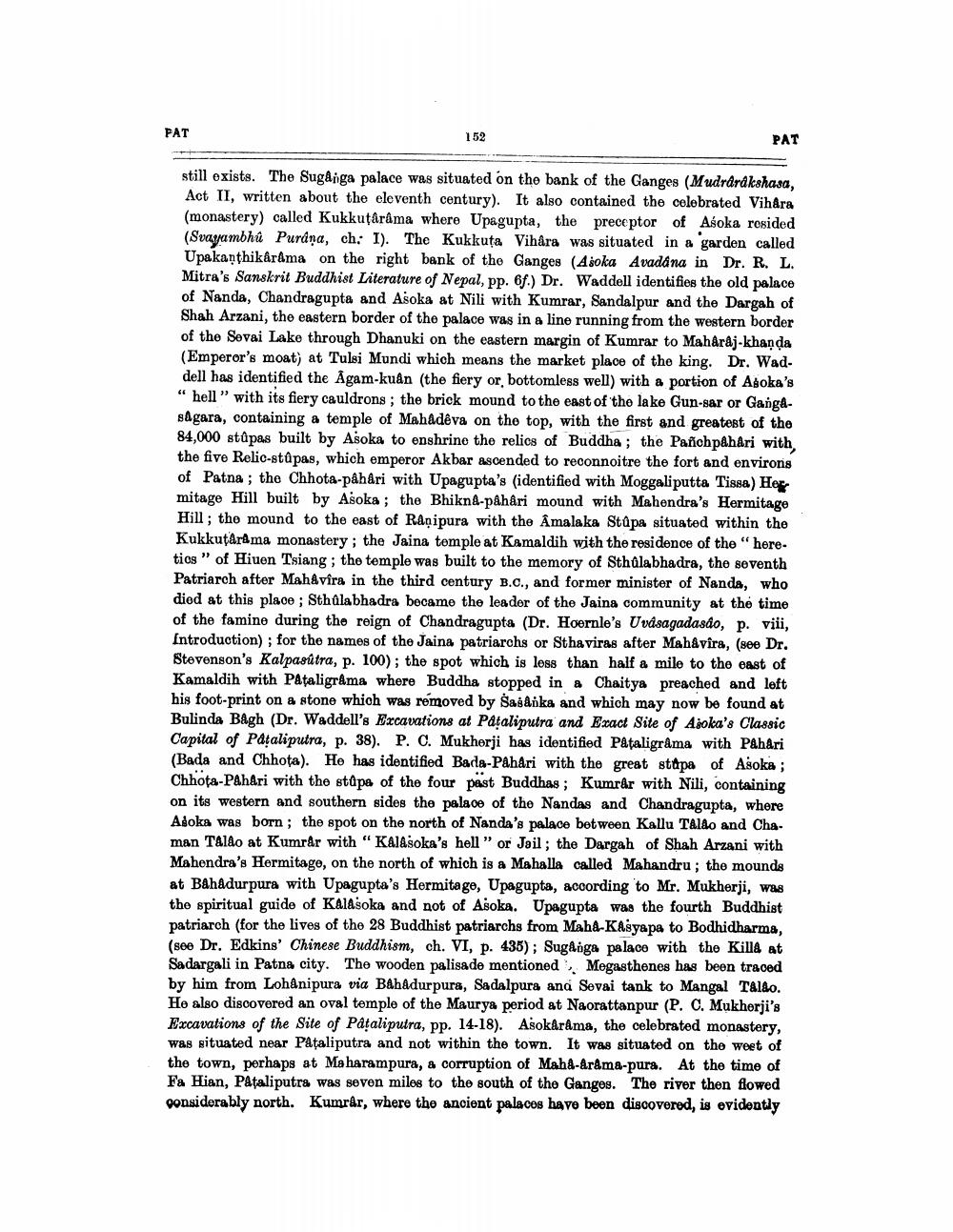________________
PAT
152
PAT
still exists. The Sugaiga palace was situated on the bank of the Ganges (Mudrårdkshasa, Act II, written about the eleventh century). It also contained the celebrated Vihara (monastery) called Kukkuțârâma where Upagupta, the preceptor of Asoka rosided (Svayambhú Purana, ch: I). The Kukkuta Vihara was situated in a garden called Upakanthikarama on the right bank of the Ganges (Asoka Avadana in Dr. R. L. Mitra's Sanskrit Buddhist Literature of Nepal, pp. 6f.) Dr. Waddell identifies the old palace of Nanda, Chandragupta and Asoka at Nili with Kumrar, Sandalpur and the Dargah of Shah Arzani, the eastern border of the palace was in a line running from the western border of the Sovai Lake through Dhanuki on the eastern margin of Kumrar to Maharaj.khanda (Emperor's moat) at Tulsi Mundi which means the market place of the king. Dr. Waddell has identified the Agam-kuân (the fiery or, bottomless well) with a portion of Asoka's "hell” with its fiery cauldrons; the brick mound to the east of the lake Gun-sar or Gangsagara, containing a temple of Mahadeva on the top, with the first and greatest of the 84,000 stúpas built by Asoka to enshrine the relics of Buddha ; the Pañchpahari with the five Relic-stūpas, which emperor Akbar ascended to reconnoitre the fort and environs of Patna; the Chhota-påhæri with Upagupta's (identified with Moggaliputta Tissa) Her mitage Hill built by Asoka; the Bhiknd-påhári mound with Mahendra's Hermitage Hill; the mound to the east of Ranipura with the Amalaka Stapa situated within the Kukkutarama monastery; the Jaina temple at Kamaldih with the residence of the "heretios” of Hiuen Tsiang; the temple was built to the memory of Sthûlabhadra, the seventh Patriarch after MahAvira in the third century B.C., and former minister of Nanda, who died at this place; Sthalabhadra became the leader of the Jaina community at the time of the famine during the reign of Chandragupta (Dr. Hoernle's Uvdsagadasáo, p. viii, Introduction); for the names of the Jaina patriarchs or Stha viras after Mahåvirs, (see Dr. Stevenson's Kalpasútra, p. 100); the spot which is less than half a mile to the east of Kamaldih with PAtaligrAma where Buddha stopped in & Chaitya preached and left his foot-print on a stone which was removed by Sasanka and which may now be found at Bulinda Bagh (Dr. Waddell's Excavations at Pataliputra and Exact Site of Ajoka's Classic Capital of Pataliputra, p. 38). P. C. Mukherji has identified Pataligrama with Pahari (Bada and Chhota). He has identified Bada-Pahari with the great stopa of Asoka ; Chhota-PAhåri with the stúpe of the four past Buddhas ; Kumrår with Nili, containing on its western and southern sides the palace of the Nandas and Chandragupta, where Asoka was born; the spot on the north of Nanda's palace between Kallu Taldo and Cha. man Taldo at Kumrar with "Kalasoka's hell” or Jail; the Dargah of Shah Arzani with Mahendra's Hermitage, on the north of which is a Mahalla called Mahandru ; the mounds at Bahadurpura with Upagupta's Hermitage, Upagupta, according to Mr. Mukherji, was the spiritual guide of Kalasoka and not of Asoka. Upagupta was the fourth Buddhist patriarch (for the lives of the 28 Buddhist patriarchs from Mahd-Kasyapa to Bodhidharma, (see Dr. Edkins' Chinese Buddhism, ch. VI, p. 435); Suganga palace with the Kille at Sadargali in Patna city. The wooden palisade mentioned, Megasthenes has been traced by him from Lohanipura via Bahadurpura, Sadalpura ana Sevai tank to Mangal Taldo. He also discovered an oval temple of the Maurya period at Naorattanpur (P. C. Mukherji's Excavations of the Site of Pataliputra, pp. 14-18). Asokarama, the celebrated monastery, was situated near Pataliputra and not within the town. It was situated on the weet of the town, perhaps at Maharampura, & corruption of MahA-arama-pura. At the time of Fa Hian, Pataliputra was seven miles to the south of the Ganges. The river then flowed considerably north. Kumrår, where the ancient palaces have been discovered, is evidently




